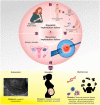Role of endometrial microRNAs in repeated implantation failure (mini-review)
- PMID: 36060804
- PMCID: PMC9437697
- DOI: 10.3389/fcell.2022.936173
Role of endometrial microRNAs in repeated implantation failure (mini-review)
Abstract
MicroRNAs (miRNAs) play various roles in the implantation and pregnancy process. Abnormal regulation of miRNAs leads to reproductive disorders such as repeated implantation failure (RIF). During the window of implantation, different miRNAs are released from the endometrium, which can potentially reflect the status of the endometrium for in vitro fertilization (IVF). The focus of this review is to determine whether endometrial miRNAs may be utilized as noninvasive biomarkers to predict the ability of endometrium to implant and provide live birth during IVF cycles. The levels of certain miRNAs in the endometrium have been linked to implantation potential and pregnancy outcomes in previous studies. Endometrial miRNAs could be employed as non-invasive biomarkers in the assisted reproductive technology (ART) cycle to determine the optimal time for implantation. Few human studies have evaluated the association between ART outcomes and endometrial miRNAs in RIF patients. This review may pave the way for more miRNA transcriptomic studies on human endometrium and introduce a specific miRNA profile as a multivariable prediction model for choosing the optimal time in the IVF cycle.
Keywords: art; endometrial receptivity; miRNAs; pregnancy; transcriptome.
Copyright © 2022 Goharitaban, Abedelahi, Hamdi, Khazaei, Esmaeilivand and Niknafs.
Conflict of interest statement
The authors declare that the research was conducted in the absence of any commercial or financial relationships that could be construed as a potential conflict of interest.
Figures



Similar articles
-
Role of miRNAs in preimplantation embryo development and their potential as embryo selection biomarkers.Reprod Fertil Dev. 2022 May;34(8):589-597. doi: 10.1071/RD21274. Reprod Fertil Dev. 2022. PMID: 35440361 Review.
-
Endometrial miRNome profile according to the receptivity status and implantation failure.Hum Fertil (Camb). 2022 Apr;25(2):356-368. doi: 10.1080/14647273.2020.1807065. Epub 2020 Aug 26. Hum Fertil (Camb). 2022. PMID: 32842822
-
Uterine fluid microRNAs in repeated implantation failure.Clin Chim Acta. 2024 May 15;558:119678. doi: 10.1016/j.cca.2024.119678. Epub 2024 Apr 17. Clin Chim Acta. 2024. PMID: 38641194 Review.
-
Uterine fluid microRNAs are dysregulated in women with recurrent implantation failure.Hum Reprod. 2022 Apr 1;37(4):734-746. doi: 10.1093/humrep/deac019. Hum Reprod. 2022. PMID: 35147192 Free PMC article.
-
Expression and significance of miR-30d-5p and SOCS1 in patients with recurrent implantation failure during implantation window.Reprod Biol Endocrinol. 2021 Sep 8;19(1):138. doi: 10.1186/s12958-021-00820-2. Reprod Biol Endocrinol. 2021. PMID: 34496883 Free PMC article.
Cited by
-
The role of viral infection in implantation failure: direct and indirect effects.Reprod Biol Endocrinol. 2024 Nov 11;22(1):142. doi: 10.1186/s12958-024-01303-w. Reprod Biol Endocrinol. 2024. PMID: 39529140 Free PMC article. Review.
-
miR-665-Mediated Regulation of AHCYL2 and BVES Genes in Recurrent Implantation Failure.Genes (Basel). 2024 Feb 15;15(2):244. doi: 10.3390/genes15020244. Genes (Basel). 2024. PMID: 38397233 Free PMC article.
-
Proteomic Approaches to Unravel the Molecular Dynamics of Early Pregnancy in Farm Animals: An In-Depth Review.J Dev Biol. 2023 Dec 30;12(1):2. doi: 10.3390/jdb12010002. J Dev Biol. 2023. PMID: 38248867 Free PMC article. Review.
-
Integrated transcriptomic analysis reveals dysregulated immune infiltration and pro-inflammatory cytokines in the secretory endometrium of recurrent implantation failure patients.Life Med. 2024 Oct 21;3(5):lnae036. doi: 10.1093/lifemedi/lnae036. eCollection 2024 Oct. Life Med. 2024. PMID: 39872439 Free PMC article.
-
Altered microRNA composition in the uterine lumen fluid in cattle (Bos taurus) pregnancies initiated by artificial insemination or transfer of an in vitro produced embryo.J Anim Sci Biotechnol. 2024 Sep 13;15(1):130. doi: 10.1186/s40104-024-01083-8. J Anim Sci Biotechnol. 2024. PMID: 39267128 Free PMC article.
References
-
- Azarpoor A., Ardeshirylajimi A., Mohammadi Y. S., Dehghan Z., Salehi M. (2020). The expression of miR-31 and its target gene FOXP3 in recurrent implantation failure patients. Int. J. Women's Health Reprod. Sci. 8, 389–395. 10.15296/ijwhr.2020.62 - DOI
Publication types
LinkOut - more resources
Full Text Sources

